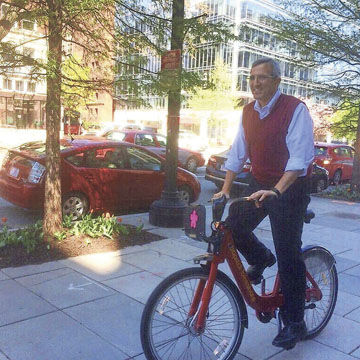By Pam Hersh
Feature stories about Princeton residents making significant contributions to the community generally begin with the following descriptive phrase(s): “long-time Princeton resident,” “life-long Princeton resident,” “native Princetonian.”
When I got to know Princeton cycling advocate Nat Bottigheimer, who serves with me on the Princeton Traffic and Transportation Committee, now reconfigured as the Princeton Complete Streets Committee, I was surprised to learn that this dedicated and hard-working community volunteer rode into town only four years ago. The suburban myth is that he arrived by bike.
Looking into his background, however, one discovers that Nat has a long-time connection to Princeton through his wife, Eve Ostriker, a Princeton University astrophysicist and daughter of another Princeton University astrophysicist and former Princeton University Provost Jeremiah Ostriker. While the father-daughter team is changing the world by focusing on outer space, Nat is changing the world in a more grounded way by focusing on spaces like bike paths within his own community.
When Nat, a Harvard- and UC Berkeley-educated, public-policy expert, is not riding his bike, he is writing, speaking, and thinking about bike riding, and how to improve the biking experience through sensible planning leading to bike-centric improvements in the community.
An associate in the Washington D.C. office of the transportation-planning firm Fehr & Peers, Nat serves as the company’s Washington D.C. Region Market Lead, utilizing his more than two dozen years of experience in coordinated land-use and transportation planning. He specializes in transit-oriented development (TOD) and station-access planning, surface-transit planning, transportation performance measurement and strategic planning, policy development, and program development for executive-level decisions.
He is sharing his professional transportation planning expertise with the community by providing input into the compilation of the Princeton Bike Master Plan. Through a grant provided by the New Jersey Department of Transportation, Princeton is working with Parsons Brinckerhoff of Lawrenceville to create a new Bicycle Master Plan for Princeton. The study will produce a Bicycle Master Plan including a network map and typical design cross sections that can be adopted as a part of the “circulation element” of the Princeton Community Master Plan. The plan will be a blueprint to support the installation of appropriate bicycle accommodations.
”The value of any plan is to let people know what to expect, so they are not surprised by what happens in the future,” said Nat. “The document has to be clear about what the streets will look like, and which projects should get priority as far as capital expenditures. The articulation of inspiring words and goals is inadequate in a planning document — unless the document also has the teeth necessary to achieve the goals.” Reflecting on his expertise in transportation performance measurement, he believes a strategic plan must utilize quantitative metrics to support the value of any transportation improvements or initiatives.
One priority that Nat would love to see included in the Princeton Bicycle Master Plan is a bike path adjacent to the Dinky tracks that would provide a connection (crossing Route 1) between Princeton and Princeton Junction. This suggestion is specific, and certainly the worthiness of such an initiative would be measurable.
With all his public policy and governmental expertise, he is well aware of the challenges in trying to bring the various parties — West Windsor, Princeton, New Jersey Transit, and Princeton University — together to accomplish such an improvement. “But it needs to be studied and measured — it would be a great project for a public-policy class working with transportation engineering students, as well as the university’s sustainability and transportation administrators.” He applauds the university and town officials for embracing the bike-share program but would love to see the metrics that would prove the increase in bike activity because of the bike-share program.
Dividing his time between his Washington D.C. corporate office and his Princeton home office, Nat uses bike transportation to get around both towns — his own bike in Princeton and the Capital Bikeshare program in Washington. “I bike because I want to, not because I have to,” he says. “Yes, I do drive… I have a car, but find that biking is more efficient and far more pleasant than being in a car. Whenever I drive I wish I weren’t driving.”
Although he loves biking to work, he finds greater joy in biking to play. He specializes in ultra-long bike trips, preferably those that include his wife and two daughters, one who is graduating from MIT and the other who is a junior at Princeton High School. His next excursion is a bike trip from Burlington, Vermont to Princeton (he takes a train to Burlington and then bikes home). His bucket-list trip is to take five or six weeks and bike the trail along the Continental Divide.
”I believe that biking and walking, as alternatives to driving, would be more prevalent in our culture if it weren’t such a status symbol to portray oneself as always being incredibly busy,” Nat said. “For those who love being busy, I would like to point out that biking is often faster than any other mode of transportation — and has the added advantage of connecting you with your community.”
As a walker who is passionate about the joys of self-propelled transit, I am grateful that Nat has turned his love of biking into a productive connection with the community.

